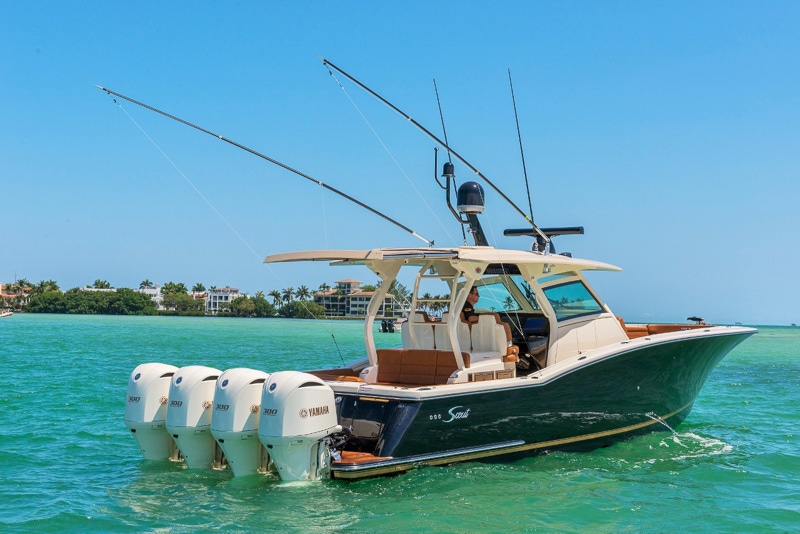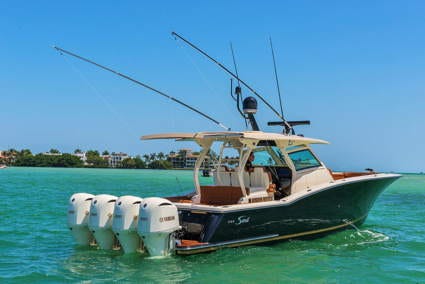Epoxy resin system reduces weight, secondary rework of mirror-finish black hull
When Scout Boats Inc. began considering the infusion process for the new hull of its 420 LXF luxury sport boat, the company decided on the process of building a vacuum-tight, flanged tool and infusing resins in a closed mold. As a result of this decision, a test program was established for infusing a dark-colored hard-top for a small boat using polyester, vinyl ester, as well as epoxy resin supplied by Huntsman Advanced Materials. The goal: to compare the handling and cured performance of each material.
December 7, 2015

When Scout Boats Inc. began considering the infusion process for the new hull of its 420 LXF luxury sport boat, the company decided on the process of building a vacuum-tight, flanged tool and infusing resins in a closed mold. As a result of this decision, a test program was established for infusing a dark-colored hard-top for a small boat using polyester, vinyl ester, as well as epoxy resin supplied by Huntsman Advanced Materials. The goal: to compare the handling and cured performance of each material.
|
Epoxy resin systems brings numerous advantages to boat hull design, |
One of the major tasks to be met during production was creating the black hull. The design team acknowledged that this would be a challenge, as imperfections on this color would be easy to notice. Fabrication with polyester resins often requires the addition of print blockers and barrier plies to prevent surface distortions and blemishes. Furthermore, completed hulls typically need time-consuming secondary rework and refinishing. The black epoxy-infused hull fabricated from Huntsman's Araldite LY 1568 and Aradur 3492 grades required little, if any, secondary finishing after demolding which radically reduced labour time and improved the overall production speed.
The hard-tops built for the test program confirmed the drawbacks of using polyester and vinyl ester resins on dark-colored parts. By contrast, the epoxy resin, which has a cured shrinkage of less than 2%, compared to 7-10% for polyester and vinyl ester, yielded blemish-free parts direct from the mold.
The benefits of using epoxy went well beyond the surface. Epoxy resin is 20-30% stronger than polyester and vinyl ester materials with a higher elongation, tensile strength and modulus/stiffness properties. As a result, Scout was able to decrease the number of laminate layers without affecting strength and performance. Overall weight was reduced by 15% as well, providing for greater hull speed and reduced fuel consumption. The structurally sound, epoxy-infused hull would also resist osmotic weight gain from water absorption over time.
Scout built a vacuum-tight mold for the new hull using vinyl ester/fiberglass/core sandwich construction. To fabricate the hull, production began with a polyester gel coat backed by a fiber-filled vinyl ester skin coat. After sanding the skin coat, multiple plies of dry fiberglass were pre-cut according to a computer-designed laminate orientation schedule and a lightweight, rigid foam core was then sandwiched between the fiberglass laminate layers. Next, a tackifier adhesive was sprayed over all plies to secure them in place until the epoxy is infused. To optimize the infusion process, a layer peel ply backed with external flow media was then put down.
To prepare for infusion, a disposable vacuum bag was installed, securing it tightly to mold flanges to eliminate air leaks. A series of resin infusion lines was then added with each line number-coded according to which area of the hull they will feed.
Araldite LY 1568 and Aradur 3492 resin and hardener were mixed and infused using a high-feed MVP Patriot Pump. The high-performance resin system, specially formulated for use on large parts, has a water-like viscosity that accommodates controlled resin flow throughout the laminate. This ensures complete wet-out of reinforcing fabrics without resin-starved areas even in the notched sections of the stepped hull. After infusion, the epoxy cures at room temperature and is then post-cured under a tarp with a heat blanket that maintains a temperature of 160°F for eight hours.
Matthew Pogue, Commercial Representative at Huntsman Corporation elaborated: "Our new, advanced epoxy resins post-cure at lower temperatures than previously possible. Light-colored parts can be cured at room temperature and yet still achieve high-quality results. As a result, energy costs are minimized while process control is maximized."
As a further consequence of this, it was possible to reduce the number of infusion lines required and decrease injection time from 1.5 hours to 45 minutes. It was also noted that closed, infusion molding is faster than the previously used open-molding process. Scout is now able to produce each hull in less than a week and a completed boat every 3 to 3.5 weeks.
Based on the performance of Araldite LY 1568 and Aradur 3492, the company is already planning to build new 35-foot and 32-foot luxury fishing boats via infusion. Historically, the epoxy infusion process has widely been used by boat builders, for single hull projects, but now Scout is leading the way for use of infusion for continuous production of boats by the marine industry.
You May Also Like



